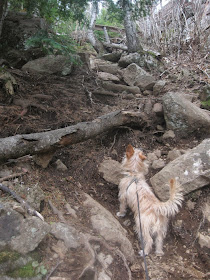If you've been in the dog world at all - whether in training classes on forums or just talking to friends - you've probably heard this bit of folk wisdom. And for the most part, I get it. Most normal dogs in the United States are under exercised both physically and mentally, and therefore bored out of their minds. For the vast majority of dogs, adding in some extra cardio, puzzle toys, or training time will go along way to reducing nuisance behaviors like barking, chewing, or mischief-making.
But there are times this phrase just gets under my skin, usually when it's applied to reactive dogs. Some advice-givers seem to think that if you just increase your dog's activity a bit, you'll reduce the amount of barking, growling, and lunging that happens...and it just isn't so!
The big problem with this is that your dog is going to be exposed to way more things. If you usually walk your dog for 30 minutes a day and increase it to an hour, you've just doubled the number of triggers your dog is being exposed to. Each trigger your dog encounters - whether he reacts or not - increases the amount of water going into his "stress bathtub."
Being exhausted because you're stressed out is not the same as being exhausted because you've used your body in a satisfying way. Last week, I came home from work absolutely exhausted. I'd had a headache for a few days. In the morning, I had an argument with a friend. Then, I came into one of those work situations that makes you bang your head and say bad words. I was pretty tired by the time I got home, but ask my husband: I was NOT a good wife that night.
 |
| Yup, that's the trail. |
Another problem is trigger stacking. Let's say your dog does great on his walks, comes home and sleeps quietly, and is overall pretty good. What happens if something unexpected happens? Does he stay "good" or does he suddenly surprise you with an over-the-top reaction? If it's the latter, you've just fallen prey to trigger stacking.
Trigger stacking is not exclusive to reactive dogs. The ability to cope with events, regardless of underlying temperament, is a limited resource. We usually think of trigger stacking in the context of "the straw that broke the camel's back," but there comes a point where a good thing becomes too much of a good thing. I love a good Thanksgiving Dinner... once a year. But after a week of leftovers, I'm really quite happy not to see another piece of pumpkin pie for a year. I've had too much, and if you offer me more turkey a week later, my response may not be good.
Now, I'm not saying that reactive dogs shouldn't get exercised. The endorphins that are released in the pursuit of physically using one's body can go a long way towards improving one's mood. But you do need to be thoughtful about how, where, and when you do it.
If you think your reactive dog would benefit from increased exercise, here are some general guidelines:
- Start slow. A couch potato cannot just get up and run a marathon. Doing so will result in pain or injury. This is NOT a good tired. Condition your dog so that the exercise is as pain-free and enjoyable as possible.
- Choose areas that are low-stress. When I was working through Maisy's reactivity, even though I had a perfectly good neighborhood to walk in, it was just full of triggers. I ended up driving her several miles away for our daily walks so that we could enjoy exercise time in a quiet, relatively unused park instead.
- Choose off-peak times. City-dwellers know how hard it is to find quiet locations, so you may have to settle for quiet times. Late nights and early mornings are familiar to many a reactive dog owner.
- Think outside of the daily walk box. Physical exercise can be anything that satisfies the need to move.
- Pick physical activities you both enjoy. Napoleon loves to run. I broke my ankle the last time I went running. We probably won't do that one again. Lola loves long sniffy walks, but strenuous hikes just aren't her thing. Taking her backpacking would be torture. Both Lola and I will be grumpy if you try to get us to do a sport we hate.
- Watch arousal levels! If playing with a flirt pole gets your reactive dog so amped up that he can't think, you're probably creating a dangerous situation - especially if he can't settle afterwards. Sort of the exact opposite of the good dog you're trying to get.

Good post! Exercise isn't going to fix reactivity - but may make the dog easier to live with at home (if home is trigger-less).
ReplyDelete